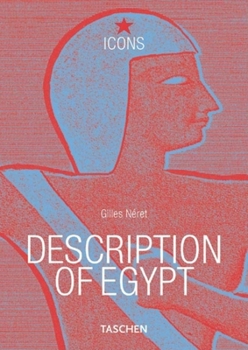Description of Egypt
(Part of the Taschen Icons Series)
In 1798, Napoleon Bonaparte launched an expedition of 35,000 soldiers to conquer Egypt. The campaign was a military and political disaster but nonetheless it had a profound and lasting impact, by... This description may be from another edition of this product.
Format:Paperback
Language:English
ISBN:3822855537
ISBN13:9783822855539
Release Date:June 2001
Publisher:Taschen
Length:192 Pages
Weight:0.85 lbs.
Dimensions:0.6" x 5.8" x 7.9"
Customer Reviews
5 ratings
Good bargain
Published by Thriftbooks.com User , 16 years ago
This is not a scholarly work, but is very useful for 1) graphic designers who need some exotic inspiration from time to time; 2) fans of ancient Egyptian who have read a great deal but failed to visualize what they've read. Its size allows you to bring it around; and the price is surprisingly low. All these make buying it an easy decision.
Description of Egypt
Published by Thriftbooks.com User , 16 years ago
A nice picture book but does not provide everything from the original volumes. It has very little text and not all of the pictures are provided.
Useful adjunct to any history of Egypt
Published by Thriftbooks.com User , 18 years ago
The Description de l'Egypte is a reproduction of the Napoleonic Egyptian Expedition's work. The book consists only of plates (with a very brief 3 page introduction) most of which are in black and white although a few are in colour. It contains sections on antiquities, contemporary Egypt (at the time of the expedition), as well as sections on flora, fauna and mineralogy. There is no commentary on the plates and they are presented without any explanation of their ordering. This can be disorienting at first but one quickly comes to realize that, for each location, plates describing general details come first and are followed by plates with progressively greater detail. For example, a description of the Isle de Philae begins with a map showing its location, a more detailed map of the island, then several views of the island from different angles and then architectural drawings of the temples on the island. It ends with details of the temple carvings and hieroglyphics. This book serves as a magnificent addendum to almost any Egyptian history text, providing great depth and detail of illustration of most of the major sites in Egypt. Even illustrated texts (ie. The Oxford History of Ancient Egypt) do not approach the same level of visual detail as the Description. There are two quibbles about the book's format that lead me to give the book 4 stars instead of 5. The first is that the book is too small. It is a paperback with 1008 pages, and not a very large paperback at that. This book would have been truly great (albeit much more expensive) if it had been a full-size hardcover. The second detail is that the plate captions are untranslated. This may be a concern to you if you do not speak French. Overall, I would highly recommend this book to anyone interested in Egyptian history or archeology. It might also be an interesting tool for those interested in architecture or design, given its attention to fine details of early Egyptian constructions.
The birth of Egyptology
Published by Thriftbooks.com User , 18 years ago
This is almost entirely a book of illustrations, with a few in color. The brief introductory text section is given in French, English and German. Most of the illustrations are not captioned, those that do have captions are only in French. Napoleon's expedition to Egypt at the end of the 18th century was a military and political fiasco. However, it did give birth to Egyptology. 500 civilians accompanied Napoleon's army, among them a group of 167 scholars in various fields. Among the many incredible discoveries made by Napoleon's group was the Valley of the Kings and the Rosetta Stone. This volume presents thousands of drawings made by this group of scholars. About half the book is devoted to detailed drawings of archaeological finds; the other half to "Etat Moderne" -- the Egyptian people, contemporary (about 1799-1800) architecture and scenery, tools, dress, the fishes of the Nile, reptiles, insects, plant life, rocks and minerals, and more. The section on birds is in color. Detailed maps drawn by the expedition members are included as well. This was an incredible achievement, especially when you consider the conditions under which these young people were working -- traversing a country at war under the stifling heat of southern Egypt, always with the sense that time was short. The French troops had been abandoned by Napoleon (who had returned to France), deprived of munitions and decimated by dysentery and epidemics; they were easy prey for the English and Turks. The members of the Commission of Science and Art were told to hand over their work to the English; they stubbornly threatened to burn their work rather than do so. Finally the English allowed the writings through and confiscated the objects, including the Rosetta Stone. In 1802, Napoleon ordered the Imperial Press to begin publication of the cultural and scientific spoils of the Egyptian expedition. 400 copper engravers worked for some twenty years. The original publication comprised ten folio volumes and two anthologies, and contained 837 copper engravings and more than 3000 illustrations in total.
Plates of French 1798 expedition to Egypt
Published by Thriftbooks.com User , 21 years ago
Complete copy of the plates from the French Expedition to Egypt in 1798. Quality of plates is surprisingly good considering the small size of the book in comparison to the originals. Excellent purchase for anyone interested in the expedition or for someone who is buying the plates individually. I would give it five stars except for the size.





